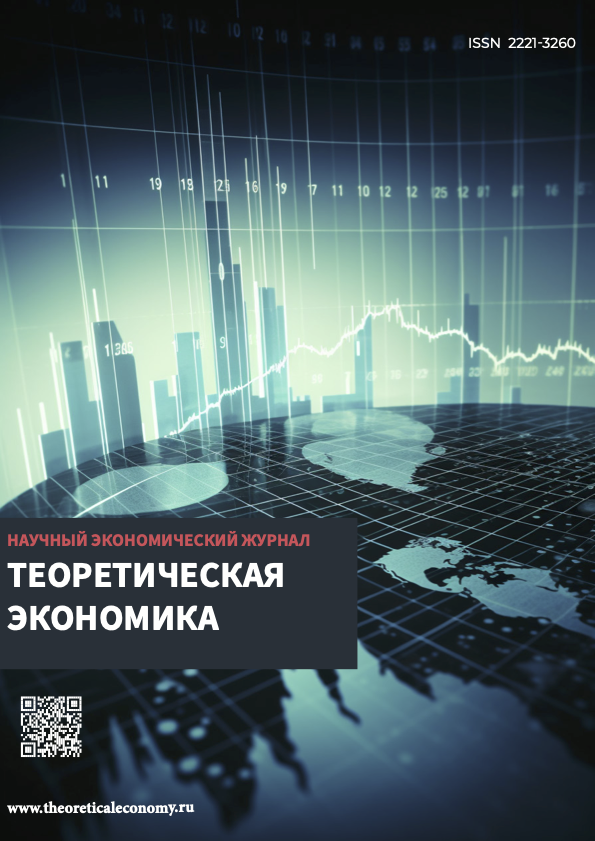Moskva, Moscow, Russian Federation
Moskva, Moscow, Russian Federation
Based on the provisions of the international doctrine in the field of sustainable development1, as well as on the system of national indicators developed in the Russian Federation that reflect the achievement of the sustainable development goals (SDGs), many economists, ecologists and sociologists offer indicators to assess the effectiveness of measures taken by the governments of various countries, including Russia, in order to achieve global and national sustainable development goals (SDGs), which is understood as such development of the countries of the world at the present time, which should provide a decent life for the population of these countries in the present and future, i.e. preserve the conditions for the progressive development of mankind for future generations and its environment, i.e. taking into account both natural (for example, climate change, loss of biodiversity, etc.), and man-made (emissions into the environment of various types of human waste), changes in the environment. The triune concept of sustainable development of all countries of the world, adopted in September 2015 at a meeting of the UN General Assembly for the period up to 2030, assumed the consideration of the territory of any country as an eco-socio-economic system that has its own specific national characteristics, but at the same time based on global goals sustainable development (17 SDGs). Some of the results of the development of a universal indicator of sustainable development of the internal territories of the Russian Federation (its constituent entities) presented in this study, taking into account the level of well-being of their population at a certain level of return of the natural environment, the degree of satisfaction with living conditions, the provision of education, are relevant, promising, contain elements of scientific novelty in part reflection in the modified Human Development Index (MHDI) of the environmental and economic components for each inland territory of the Russian Federation (diversification of the “ecological footprint” and GDP). The presented indicator is constantly undergoing changes due to the receipt of new data, changes in the territorial boundaries of the internal territories of the Russian Federation and the establishment of latent causal relationships of the indicators included in it. This indicator can be recommended for use in international comparisons of national achievements in the field of sustainable development of the states of the World etc.
sustainable development goals; interaction between economy and ecology; statistical methods for measuring influence; mixed-type index models; modification of international indices; "ecological footprint"; Nature yield of the territory.
1. Povestka dnya v oblasti ustoychivogo razvitiya do 2030 goda. Oficial'nyy sayt OON. URL: https://www.un.org/sustainabledevelopment/ru/about/development-agenda/ [Data obrascheniya 15.02.2023]
2. Celi ustoychivogo razvitiya v Rossiyskoy Federacii. 2022: Krat. stat. sb. /Rosstat – M., 2022. –87 s
3. Oficial'nyy sayt OON. Statisticheskiy otdel OON (SOOON) URL:https://unstats.un.org/sdgs/data4vnrs/ [Data obrascheniya 25.02.2023]
4. World Database of Happiness URL: http://www.happyplanetindex.org/about
5. Global Footprint Network (2008) Ecological Footprint Atlas. Oklend (SShA), Bryussel' (Bel'giya), Zheneva (Shveycariya). URL: http://data.footprintnetwork.org/ [Data obrascheniya 23/01/2021]
6. Indeksy razvitiya gosudarstv mira: Spravochnik / Sost. Gasparyan O.T., Kamalova R.U., Kocheshkova E.A., Pod red. Nisnevicha Yu.A. — M.: Izdatel'skiy dom Vysshey shkoly ekonomiki, 2014. — 248 s.
7. Bobylev S. N. Indikatory ustoychivogo razvitiya: regional'noe izmerenie. Posobie po regional'noy ekologicheskoy politike. -M.: Akropol', CEPR,2007. -60 s.
8. Krass M. C. (2010) Modelirovanie ekologo-ekonomicheskih sistem: Ucheb. posobie- M.: INFRA-M, 2010.-272 s.
9. Tikunov A.V. (2015) Integral'nye pokazateli prostranstvennyh modeley razvitiya stran mira. Izd. stereotip. - M.: Knizhnyy dom «LIBROKOM», 2015.-248 s.
10. Lipina S. A., Agapova E. V., Lipina A. V. (2018) Razvitie zelenoy ekonomiki v Rossii: vozmozhnosti i perspektivy. - M.: LENAND, 2018. -328 s.
11. Stiglic D., Sen A., Fitussi Zh.-P. (2016) Neverno ocenivaya nashu zhizn': Pochemu VVP ne imeet smysla?/ Doklad Komissii po izmereniyu effektivnosti ekonomiki i social'nogo progressa/ per. s angl. I. Kushnarevoy; nauch. red. perevoda T. Drobyshevskaya. - M.: Izd-vo Instituta Gaydara, 2016.-216 s.
12. Arhangel'skaya L. Yu. «Ustoychivoe razvitie regionov Rossii v usloviyah «zelenoy ekonomiki» (problemy ocenki)». gl. 3.3 s. 131 -140// Ekonomiko-teoreticheskie issledovaniya v Finansovom universitete: istoriya i sovremennost': monografiya/ koll. avtorov; pod obsch. red. Karamovoy O. V., Peskovoy D. R.-Moskva, RUSAYNS, 2021.-272 s.
13. Arkhangelskaya L.Y., Salin V.N., Prasolov V.N., Danilina L.E. (2020) Sustainable Development of Regions of Russia in the Conditions of the “Green Economy” (Estimation Problems). In: Popkova E., Sergi B. (eds) Scientific and Technical Revolution: Yesterday, Today and Tomorrow. ISC 2019. Lecture Notes in Networks and Systems, vol 129. Springer, Cham. -pp.1335-1345 https://doi.org/10.1007/978-3-030-47945-9_145
14. Arhangel'skaya L. Yu. (2020) «Ekonomicheskaya emkost' prirodnoy sredy regionov Rossii (prikladnoy aspekt)» gl. 5.12, s. 373 -380// «Social'no-ekonomicheskoe razvitie v epohu global'nyh peremen»: koll. Monografiya/otv. Red. M. L. Al'pidovskaya, A. G. Gryaznova. t.2, M.-Tver', Tverskoy gosudarstvennyy universitet, 2020.-542 s.
15. Human Development Data. URL: https://hdr.undp.org/data-center [Data obrascheniya 27/03/2023]
16. Gallap (2006) The World Poll Questionnaire// URL: http://media.gallup.com
17. Doklad o chelovecheskom razvitii 2020 god. «Sleduyuschiy rubezh: chelovecheskoe razvitie i antropogen». URL: http://hdr.undp.org/sites/default/files/hdr2020_ru.pdf
18. Oficial'nyy sayt Vsemirnogo banka. URL: https://www.worldbank.org/en/home [Data obrascheniya 05.03.2023]
19. Regiony Rossii. Social'no-ekonomicheskie pokazateli. 2022: Stat. sb. / Rosstat. M., 2022. 1122 s.
20. Regiony Rossii. Osnovnye harakteristiki sub'ektov Rossiyskoy Federacii. 2021: Stat. sb./ Rosstat. M., 2021. 766 s.
21. Rossiyskiy statisticheskiy ezhegodnik. 2021: Stat. sb./Rosstat. – M., 2021. – 692 s.
22. Indeks chelovecheskogo razvitiya v Rossii. Analiticheskaya zapiska. -Analiticheskiy centr pri Pravitel'stve Rossiyskoy Federacii. URL: https://ac.gov.ru/uploads/2-Publications/analitika/2022/_2021_long.pdf
23. Doklad o celyah ustoychivogo razvitiya 2020. The-Sustainable-Development-Goals-Report-2020_ OON. URL: https://unstats.un.org/sdgs/report/2020/ [Data obrascheniya 20.02.2023]
24. «Celi ustoychivogo razvitiya». Oficial'nyy sayt Federal'noy sluzhby gosudarstvennoy statistiki (FSGS): URL: http://www.rosstat.gov.ru
25. Mezhgosudarstvennyy statisticheskiy komitet Sodruzhestva Nezavisimyh Gosudarstv (STAT SNG). Oficial'nyy sayt. URL: http://new.cisstat.org/web/guest
 This work is licensed under Creative Commons Attribution-NonCommercial-NoDerivatives 4.0 International
This work is licensed under Creative Commons Attribution-NonCommercial-NoDerivatives 4.0 International












